| |
Montana 500
Newsletter |
|
| Jan. - Feb. 2002 |
|
Volume 2 Number 1 |
| |
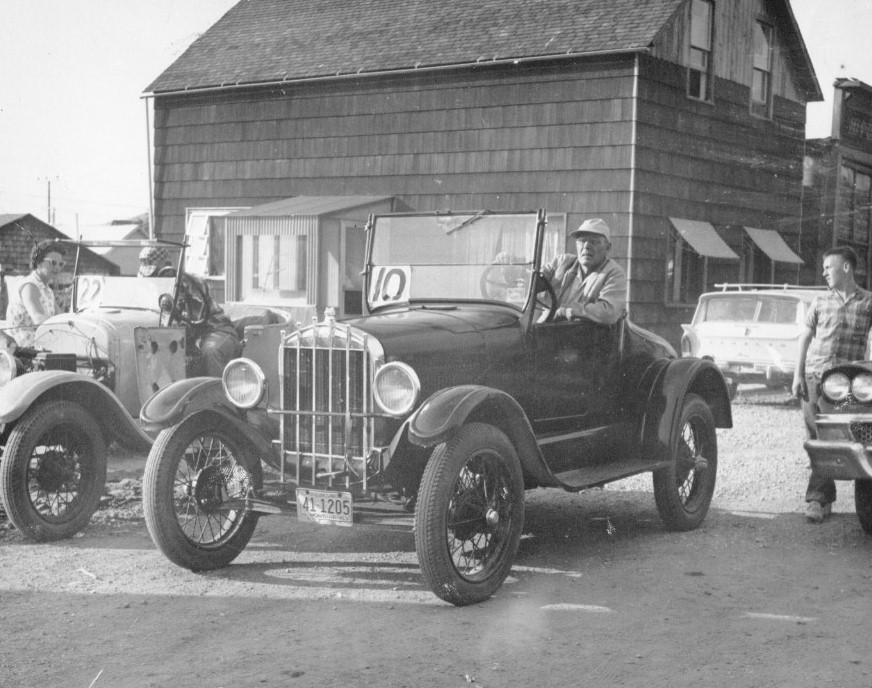 |
|
| |
|
|
| |
 |
|
| |
|
|
| |
Montana Cross Country T Assn.
|
|
| |
7516 E. Mission Spokane, WA 99212
|
|
| |
www.montana500.com
|
|
| |
2002 Officers and Directors: President: Sam Nickol
Vice President: Rick Carnegie
Sec.-Treasurer: Janet Cerovski
Directors:
Rick Carnegie 2003
Tom Carnegie 2002
Janet Cerovski 2003
Tony Cerovski 2004
Rob Flesner 2004
Mark Hutchinson 2004
Doug Langel 2002
George Nickol 2002
Sam Nickol 2003
|
|
| |
Meeting Secretary: Carla Carnegie Correspondence
and newsletter: Tom Carnegie
|
|
| |
Date of endurance run is June 17th
Membership dues $10.00
Touring class: $25.00
Endurance runner: $35.00
|
|
| |
|
|
| |
Front cover: Top picture, Lewis Rector. |
|
| |
Bottom picture, Frank Hansard and Walt Mangold. |
|
| |
Taken during 1963 race. |
|
| |
|
|
General News
Welcome to all the new members.
Thank-you for joining our club. By next newsletter we
should have a base hotel nailed down. The price of gas
has been dropping steadily in my neck of the woods. This
should make the run a little easier on everyone’s
pocket book. As a historical note, several times in the
past Humble Oil Company (now Exxon) would sponsor our run
by supplying free gas and oil to the drivers. The free
gas would be nice, but in my case the free oil really
takes on some significance. Because of all the charts in
the technical article this is the longest newsletter that
I have put out to date. As such, there are no
drivers’ profiles this time. People have told me
that they really enjoy the driver’s profiles. Maybe
I’ll do an issue of the newsletter with several
rather than just two profiles. Most every one that I have
asked to do a profile has agreed to help me. What would
really please me is to receive an unsolicited profile
from the woodwork. Vivian Peters supplied me with the
results of 1971. Bless her heart. Now the only year for
which I don’t have complete times is 1963. I believe
that somewhere, someone has the results for this. I will
continue to beat the bushes until the results show up.
Both rule proposals passed. Next newsletter I will
publish the rules in their entirety. Last newsletter I
published the term of office wrong on some of the
directors. I hope I got it right this time.
|
Having your head
examined.
|
By Tom Carnegie
|
| I have tested several different Model
T cylinder heads on a dynamometer. The motor that I used
for these tests is bored .040 oversize with Jahns
aluminum pistons. The rods were bored improperly when
they were rebabbitted, and are 1/16" short of their
correct length, so the engine is a little shy of the
amount of compression that it should have. The valves are
stock, the porting is stock, the cam is an unreground
original that I set up using the piston travel method.
The manifolding is stock with a cast iron intake and
stock exhaust pipe and muffler system. |
Dyno Basics
|
| A dynamometer essentially does one
thing. It measures torque at a given speed. If we know
torque and speed (rpm’s) we can calculate
horsepower. For instance, a motor turning 101 rpm’s
and putting out 52 foot-pounds of torque would be putting
out one horsepower. A motor putting out 52 foot-pounds of
torque at 1010 rpm’s would be putting out ten
horsepower, 10100 rpm’s 100 horsepower and so on.
But there is more to the story than this. |
Achieving a Standard
|
| Different atmospheric conditions will
effect how much power an engine will put out. In order to
have a meaningful comparison between tests done on
different days the horsepower ratings need to be
corrected for ambient conditions. The folks at the S.A.E.
have a whole set of formulas (that I won’t go into
right now) for correcting power readings to compensate
for humidity, air pressure and temperature. Then if you
take a reading on a warm muggy day the corrected readings
should equal the corrected readings taken on a cool dry
day. All of the following charts and graphs have been
corrected to standard conditions. |
 |
| Graph one: This graph compares
an unmilled low head to an unmilled high head. Although
the maximum horsepower is lower on the low head, it has
better torque on both the low and high end of the curve. |
| |
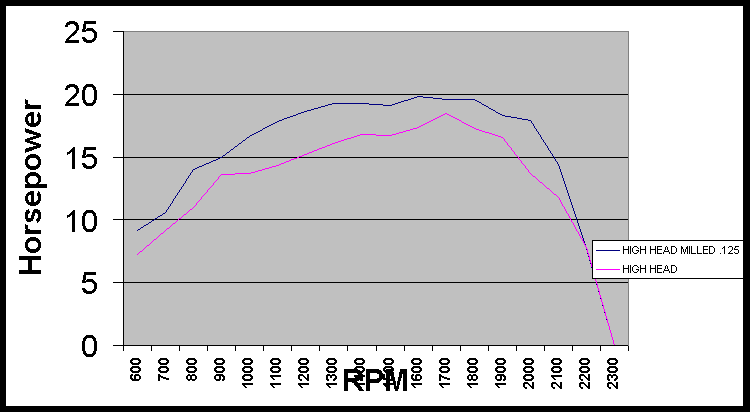 |
| Graph two: This graph compares
an unmilled high with a head milled .125”. The
milled head on this engine produced a near textbook power
curve which peaks at 20 horsepower. The extra milling no
doubt compensated for the short rods. (see text) |
| |
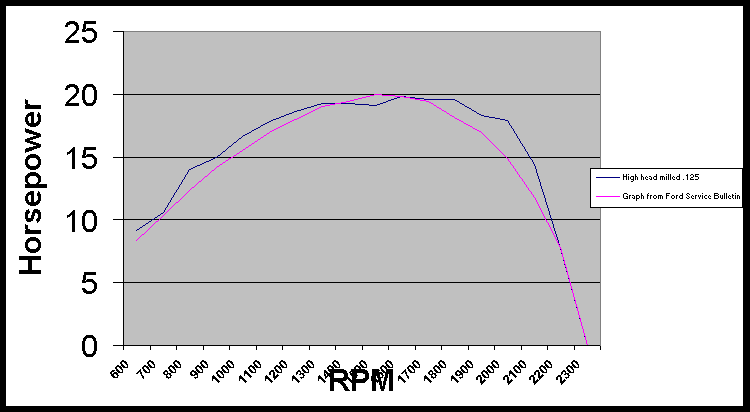 |
| Graph three: This graph
compares Ford’s data from the Service Bulletins to a
high head milled .125” |
| |
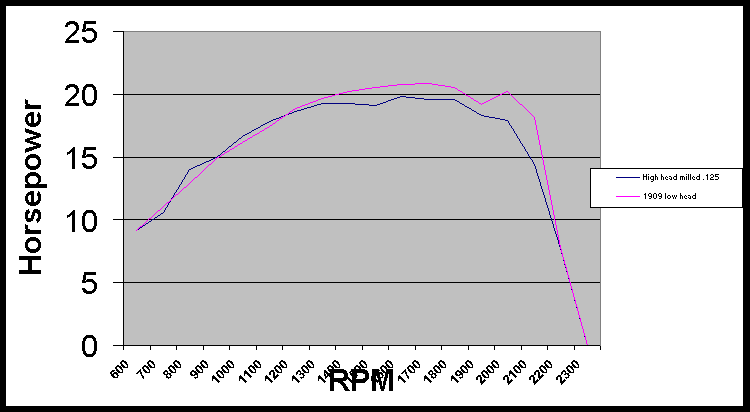 |
| Graph four: This graph compares
a 1909 head with a high head milled .125” |
| |
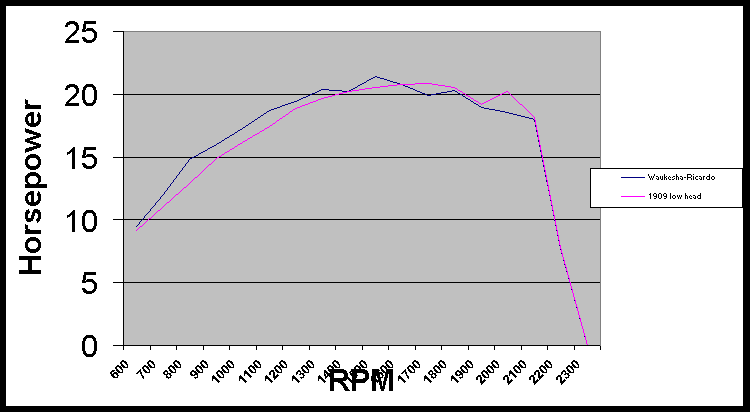 |
| Graph five: Waukesha-Ricardo
verses a 1909 head. Waukesha wins on the bottom end, Ford
on the top. |
| |
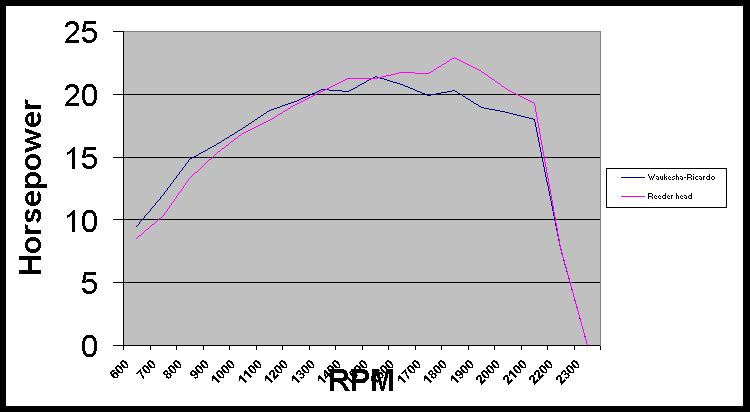 |
| Graph six: Reeder head and
Waukesha-Ricardo. Wow! talk about some easy bolt on
power. |
| |
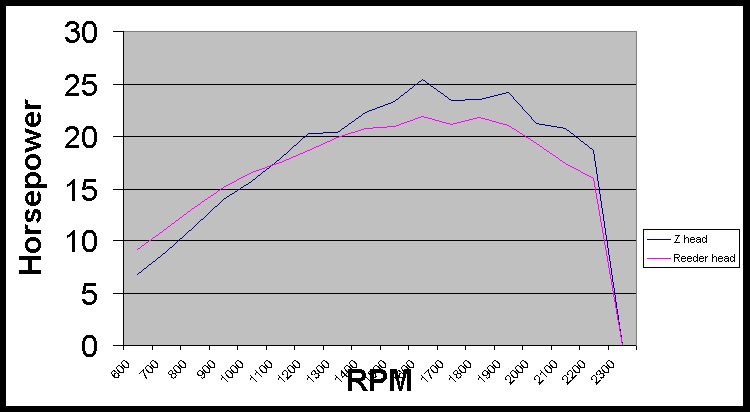 |
| Graph seven: The Reeder head is
better on low end power, but for speed the Z-head is the
champ. |
| |
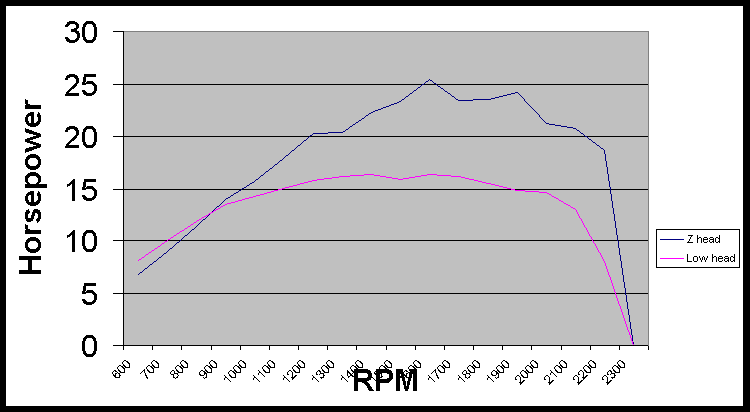 |
| |
| Graph eight compares our first head
with the last. We’ve come a long way. |
Horsepower
|
On a sad note, Gene Hansard passed away Jan. 6th.
Steve Coniff’s 30th wedding anniversary is this year so
he won’t make it to this year’s run. We’ll miss
Steve, and hope to see him in 2003.
I’ve heard at least 2 people are coming from Illinois
this year.
Gordon Carlson plans to come from North Dakota.
Rob Flesner says he is bringing two cars.
Gary Gordon from Georgia has Fred Upshaw’s “Miss Los
Angeles” car. He would like to come back and avenge
Fred’s disqualifications.
Harold Mann says four cars are coming from Nevada.
Ron Miller says two cars are coming from Ohio.
Denis Ascher from Idaho is putting a car together. He says
that he will be ready by June.
At the fall meeting we talked about doing a Missoula to
Fairview run. Ed Towe says he would be up for this if he can
procure a car by then.










